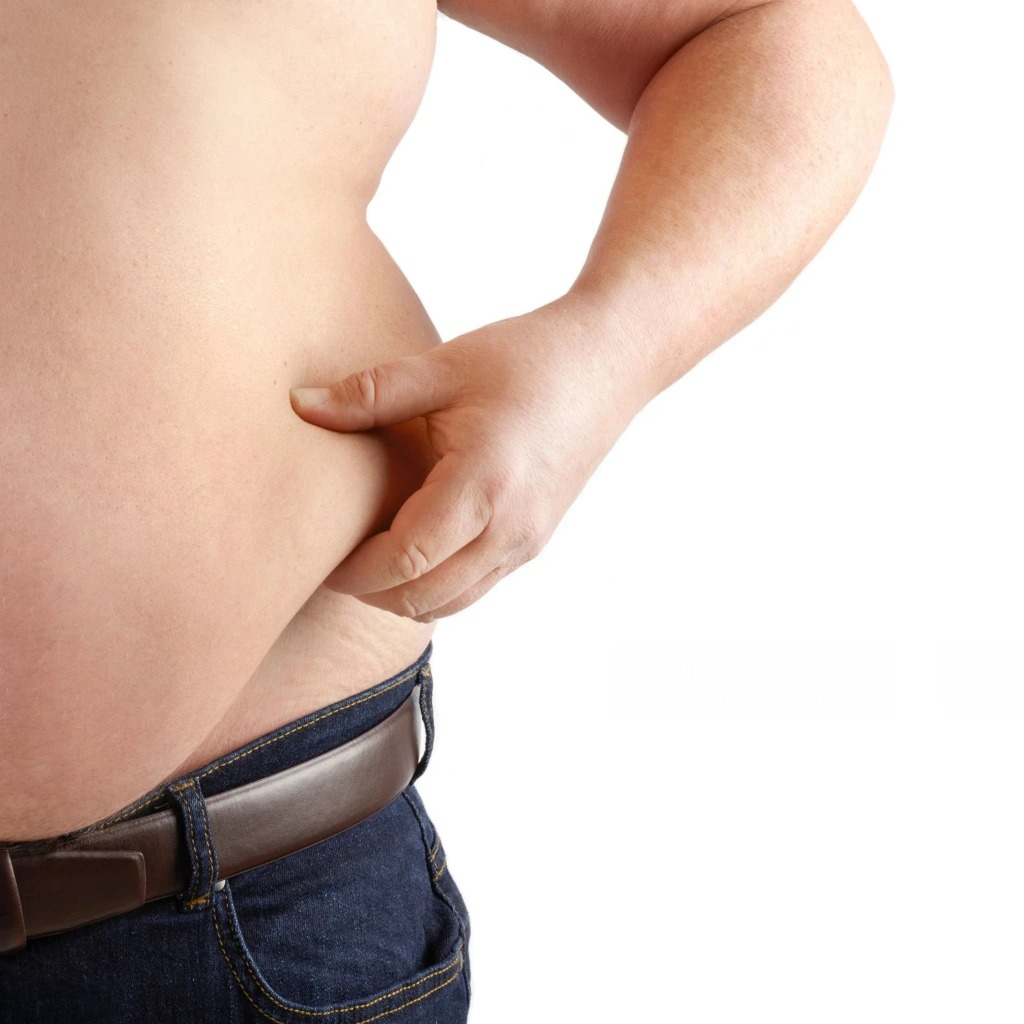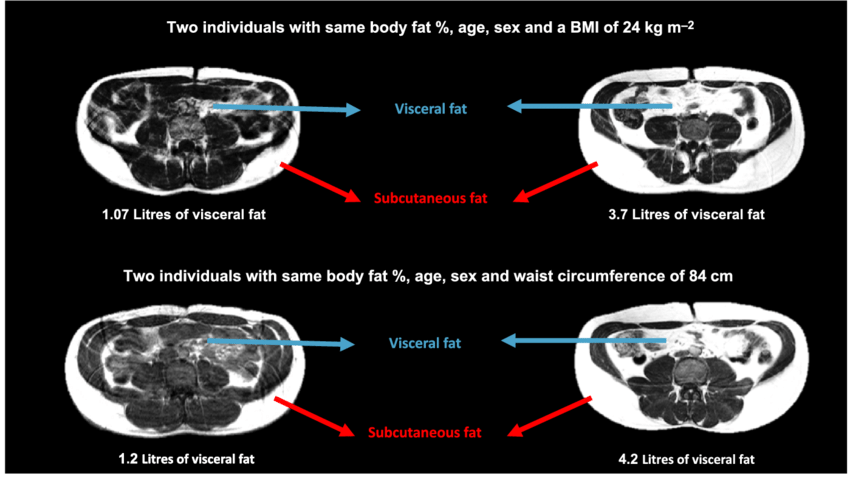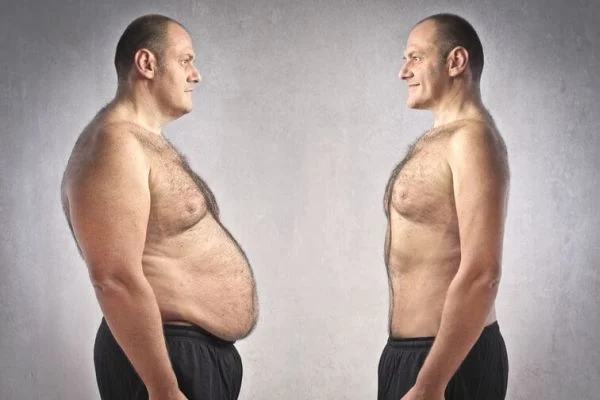
- 12 min read

Visceral Fat: The Hidden Enemy Destroying Your Health and Testosterone
Discover why visceral fat is the single greatest threat to mens health. Learn how this invisible inflammatory organ sabotages testosterone, causes chronic disease, and the proven strategies to eliminate it.
You can’t see it. You can’t pinch it. But it may be the single most dangerous threat to your long-term health, performance, and vitality. We’re not talking about the soft layer of fat under your skin. We’re talking about something far more sinister: visceral fat.
For men, especially those in their 30s and beyond who are proactive about their health—perhaps even considering or currently on Testosterone Replacement Therapy (TRT)—understanding this internal enemy is not just important; it’s critical. It’s the key to unlocking a new level of health, reversing chronic disease, and ensuring your efforts in the gym and with your diet are not being silently sabotaged from the inside out.
This isn’t just about aesthetics or fitting into old jeans. This is about the inflammatory, disease-promoting organ growing inside your abdomen, actively working against you every second of the day.
Part 1: Visceral Fat vs. Subcutaneous Fat—Not All Fat is Created Equal
 MRI comparison showing the difference between subcutaneous and visceral fat distribution
MRI comparison showing the difference between subcutaneous and visceral fat distribution
When you look in the mirror, the fat you can physically pinch on your stomach, arms, or chest is subcutaneous fat. While not ideal in excess, it is largely metabolically benign.
Visceral fat is entirely different. Imagine an MRI slice through your midsection. You would see your spine at the bottom, your abdominal muscles (your “six-pack”) and obliques forming a muscular wall, and your organs nestled inside. Visceral fat is the dense, web-like “white stuff” that infiltrates the space between these organs—your intestines, liver, and pancreas.
The critical distinction is this: visceral fat is not just inert storage. It is a highly active endocrine organ. It continuously secretes inflammatory molecules, called cytokines and adipokines, directly into your portal vein, which leads straight to your liver. This creates a constant, low-grade inflammatory state throughout your entire body, a “trickle, trickle” of disease-promoting signals that wreak havoc over time.
Think of it less as storage and more as a rogue factory inside your body, manufacturing inflammation 24/7. This is why a person can appear relatively thin—a condition sometimes called “skinny-fat”—yet be profoundly unhealthy on the inside due to a high accumulation of visceral fat.
The Special Risk for Asian Men
 Asian men face higher visceral fat risk even with normal BMI and slim appearance
Asian men face higher visceral fat risk even with normal BMI and slim appearance
While visceral fat is a threat to everyone, men of East and South Asian descent face a unique and heightened risk. Research consistently shows that at any given Body Mass Index (BMI), Asian men tend to carry significantly more visceral fat than their Caucasian counterparts. They can have dangerous levels of this internal fat even while appearing outwardly slim and having a “healthy” BMI. This genetic predisposition makes a proactive approach to visceral fat management even more crucial for this demographic.
 South Asian men particularly need to monitor visceral fat levels for optimal health
South Asian men particularly need to monitor visceral fat levels for optimal health
Part 2: The Cascade of Chronic Disease Fueled by Visceral Fat
The constant inflammatory output from visceral fat is directly linked to nearly every major chronic disease plaguing modern society. It is the common root of countless conditions.
- Insulin Resistance and Type 2 Diabetes: The inflammatory signals from visceral fat impair your cells’ ability to respond to insulin. Your pancreas works overtime to compensate, eventually burning out and leading to high blood sugar and Type 2 Diabetes.
- Cardiovascular Disease: This isn’t just about cholesterol. Visceral fat promotes high blood pressure, elevated triglycerides, and inflammation of the arterial walls, creating the perfect storm for heart attacks and strokes. The fat that accumulates directly around the heart, known as pericardial fat, is particularly dangerous and can be dramatically reduced with the right lifestyle changes.
- Non-Alcoholic Fatty Liver Disease (NAFLD): Because visceral fat dumps its inflammatory byproducts directly into the liver, it’s a primary driver of NAFLD, where the liver itself becomes infiltrated with fat, leading to dysfunction and potentially cirrhosis.
- Hormonal Disruption (Low Testosterone & ED): For the men reading this, this is a crucial connection. Visceral fat contains high levels of the aromatase enzyme, which converts your precious testosterone into estrogen. This leads to a vicious cycle: high visceral fat lowers testosterone, and low testosterone makes it easier to accumulate more visceral fat. This hormonal imbalance is a major contributor to symptoms like low energy, reduced muscle mass, and erectile dysfunction.
- Cancer: The chronic inflammation and growth factors secreted by visceral fat have been linked to an increased risk of several cancers, including colorectal and prostate cancer.
Part 3: Identifying the Enemy—How to Measure Your Visceral Fat
 Visceral fat often accumulates without obvious external signs
Visceral fat often accumulates without obvious external signs
Because you can’t see it directly, you need better tools than a bathroom scale.
The Gold Standard: Imaging
- MRI (Magnetic Resonance Imaging): This is the ultimate tool. An MRI of the abdomen provides a crystal-clear, quantifiable picture of your visceral fat. More importantly, it can reveal a secondary, equally damaging condition: myosteatosis, or fat infiltration within your muscles. This is essentially “human muscle marbling,” and it devastates muscle quality and performance. A healthy muscle on an MRI is dark and dense; a marbled muscle is riddled with white streaks of fat, making it weak and inflamed.
- CT Scan: A CT scan can also visualize visceral fat effectively, though it involves a dose of radiation.
Practical Proxies: The “Poor Man’s MRI”
While an MRI is ideal, you can get a good idea of your visceral fat burden by looking for key physical signs:
- The “Dad Bod” or Protruding Abdomen: A belly that sticks forward, even if it feels firm, is often a sign of visceral fat pushing the abdominal wall outward.
- Love Handles: This collection of fat on your back and flanks is primarily composed of deep subcutaneous fat, which has a strong correlation with visceral fat levels. If you have significant love handles, you likely have significant visceral fat.
- Spider Veins (Telangiectasis): These tiny, purple veins on your ankles, thighs, or even eyelids are a visual sign of systemic inflammation and poor vascular health, often driven by visceral fat.
- Darkened Pores on the Nose (Sebaceous Filaments): The oil in the pores on your nose (sebum) becomes more easily oxidized and darkened by systemic inflammation. Darker, more prominent pores can be a proxy for higher levels of internal inflammation.
Part 4: The 5 Main Culprits—What Causes Visceral Fat?
Based on extensive research and clinical observation, five key lifestyle factors are the primary drivers of visceral fat accumulation.
- Processed Foods (Especially Carbohydrates): This is the number one offender. Processed and ultra-processed foods, particularly refined carbohydrates (sugars, flours, industrial seed oils), are the primary building blocks of visceral fat and muscle marbling. Your body preferentially stores the energy from these foods as inflammatory visceral fat, not subcutaneous fat.
- Chronic Stress: Unmanaged psychological or emotional stress leads to chronically elevated cortisol levels. Cortisol is a hormone that directly signals your body to store fat in the abdominal area. A stressful job or chaotic life is a recipe for visceral fat accumulation, regardless of your diet. This stress-induced hormonal imbalance can also contribute to depression and mood disorders.
- Disrupted Sleep: Sleep is not optional; it is mandatory for metabolic health. Poor sleep quality or insufficient duration disrupts your circadian rhythm and key hormones like cortisol and ghrelin. Even one night of poor sleep can temporarily decrease insulin sensitivity. Chronic sleep deprivation is a potent driver of visceral fat gain.
- Alcohol: Alcohol consumption directly impacts metabolic health and contributes to fat deposition in the liver and viscera. From a health optimization standpoint, there is no “safe” amount of alcohol. For those serious about reversing visceral fat, eliminating it entirely is one of the most powerful levers to pull.
- The Wrong Kind of Exercise (Endurance vs. Intensity): This is one of the most counter-intuitive yet critical points. While we’ve been told “cardio” is the key to health, chronic, long-distance endurance exercise (like marathons or daily 10-mile runs) can actually be a form of chronic stress on the body, elevating cortisol and, in many cases, leading to the preservation or even accumulation of visceral fat in otherwise “healthy” individuals.
Part 5: The Battle Plan—Your Strategy to Eliminate Visceral Fat
The good news is that visceral fat is highly responsive to lifestyle changes. Because it’s so metabolically active, your body can burn through it relatively quickly when you give it the right signals. For men with low testosterone, TRT can provide significant benefits in this battle against visceral fat. Thanks to Sean O’Mera with his work to discover this hidden indicator of disease and his research to help to eliminate this condition that affects so many men today.
Strategy 1: Dietary Overhaul
- Eliminate the Enemy: The first step is the ruthless elimination of processed foods, refined carbohydrates, sugars, and industrial seed oils. This alone will stop the primary driver of new visceral fat deposition.
- Prioritize Protein and Healthy Fat: Build your diet around high-quality protein (grass-fed meat, wild-caught fish, pasture-raised eggs) and healthy, natural fats. This provides the building blocks for muscle and hormones without the inflammatory load.
- Incorporate Fermented Foods: Add a variety of fermented foods like kimchi, sauerkraut, kefir, and plain yogurt. These are not for their caloric value but for their microbial benefit. They help repopulate your gut with beneficial bacteria that improve digestion and reduce inflammation.
- Embrace Fasting: Fasting is a powerful tool for activating autophagy, your body’s cellular cleanup process. Start with intermittent fasting (e.g., a 16:8 schedule), but consider working up to a 24, 48, or even 72-hour fast once a month (with medical guidance) to maximize cellular repair and accelerate fat loss.
Strategy 2: Revolutionize Your Exercise
- Make Sprinting Your Priority: The single most effective form of exercise for eliminating visceral fat and building powerful, functional muscle is sprinting. Maximum intensity exercise produces beneficial molecules that build muscle and burn fat more effectively than any other activity. It targets the fast-twitch muscle fibers that are crucial for power, stability, and maintaining a high quality of life as you age.
- How to Sprint: Aim for 4-8 sprints, 2-4 times per week. A sprint can be 10-30 seconds of all-out effort. Crucially, if you are new to this, start slow. The injuries happen during acceleration. Take a full 20-30 seconds to ramp up to your max speed, hold it for 10-15 seconds, and then decelerate slowly.
- Add Resistance Training: Weightlifting is the second-best form of exercise. Focus on compound movements like squats, deadlifts, presses, and rows to build and maintain metabolically active muscle mass.
- Ditch Chronic Cardio: Replace your long, slow jogs with sprints and resistance training for superior metabolic results in a fraction of the time. Walking is still fantastic for recovery and low-level activity.
Strategy 3: Master Your Environment
- Fix Your Sleep: Get bright sunlight in your eyes first thing in the morning to set your circadian rhythm. As evening approaches, dim the lights in your home. Use blue-light blocking glasses if you must use screens. Make your bedroom a cold, dark, quiet sanctuary.
- Manage Stress with Intensity: When you feel stress rising, don’t just sit with it. Dissipate the cortisol by mimicking the “sprint from a predator” response. Go outside and do a few sprints. Drop and do a set of push-ups to failure. Lift something heavy for a few minutes. A brief, intense physical bout will metabolize the stress hormones and restore physiological balance. However, be aware that TRT can have side effects if not properly managed, so work with experienced practitioners.
- Get Into Nature: Spend time outdoors. The sunlight, fresh air, and contact with the natural world have measurable benefits for stress reduction and your microbiome.
Conclusion: Take Control of Your Internal Health
Visceral fat is the invisible enemy that drives the chronic diseases that rob men of their vitality. The number on the scale and your reflection in the mirror tell an incomplete story. True health is determined by what’s happening on the inside—in the spaces between your organs and within your muscle tissue itself.
By understanding the causes and implementing a targeted battle plan focused on a clean diet, intense exercise, restorative sleep, and stress modulation, you can defeat this enemy. You can reverse disease, optimize your hormones, and build a body that is not just leaner, but profoundly healthier and more resilient from the inside out. This is the foundation of true preventative health and performance optimization.
The Mas Clinic, takes visceral fat assessment seriously. For our Toronto patients, we can write a requisition for an abdominal MRI to precisely measure your visceral fat levels and identify muscle marbling (myosteatosis). We work with several third-party imaging centers throughout the Greater Toronto Area, to provide you with detailed imaging that goes far beyond what a standard scale or body composition analysis can reveal. This comprehensive assessment allows us to create a truly personalized treatment plan and track your progress with scientific precision as we optimize your hormone levels and metabolic health.
If you’re struggling with visceral fat and suspect low testosterone may be contributing to your challenges, start by following this post as your guide. Our Toronto testosterone replacement therapy services can help you break the vicious cycle of visceral fat accumulation and hormonal imbalance. Ready to take control of your health? Get started with getting on our waitlist today.
References
Lear, S. A., Humphries, K. H., Kohli, S., Chockalingam, A., Frohlich, J. J., & Birmingham, C. L. (2007). Visceral adipose tissue accumulation differs according to ethnic background: results of the Multicultural Community Health Assessment Trial (M-CHAT). The American Journal of Clinical Nutrition, 86(2), 353–359. https://doi.org/10.1093/ajcn/86.2.353
Tchernof, A., & Després, J. P. (2013). Pathophysiology of visceral obesity. Clinical in Plastic Surgery, 40(2), 187-193. (This is a representative review of the general concept). A more direct link: Fontana, L., Eagon, J. C., Trujillo, M. E., Scherer, P. E., & Klein, S. (2007). Visceral fat adipokine secretion is associated with systemic inflammation in obese humans. Diabetes, 56(4), 1010–1013. https://doi.org/10.2337/db06-1100
Cohen, P. G. (2001). The role of aromatase in the pathogenesis of gynecomastia. The Journal of Pediatrics, 139(4), 629. A broader review: Traish, A. M. (2014). Testosterone and weight loss: the evidence. Current Opinion in Endocrinology, Diabetes and Obesity, 21(5), 313–322. https://doi.org/10.1097/MED.0000000000000086
Shida, T., Miyauchi, H., Kono, T., et. al. (2020). Visceral fat area is a useful predictor of metachronous colorectal neoplasia. Scientific Reports, 10(1), 1959. https://doi.org/10.1038/s41598-020-58913-9
Moyer, A. E., Rodin, J., Grilo, C. M., Cummings, N., Larson, L. M., & Rebuffé-Scrive, M. (1994). Stress-induced cortisol response and fat distribution in women. Obesity Research, 2(3), 255–262. https://doi.org/10.1002/j.1550-8528.1994.tb00055.x
Covassin, N., Singh, P., & Somers, V. K. (2022). Keeping up with the clock: the role of sleep in cardiometabolic risk. Journal of the American College of Cardiology, 79(11), 1107–1109. https://doi.org/10.1016/j.jacc.2022.01.026
Was this article helpful? Let us know!